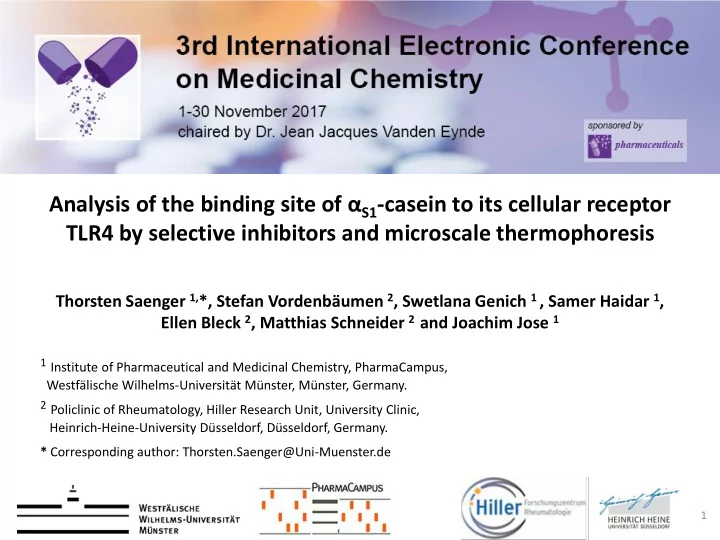

Analysis of the binding site of α S1 -casein to its cellular receptor TLR4 by selective inhibitors and microscale thermophoresis Thorsten Saenger 1, *, Stefan Vordenbäumen 2 , Swetlana Genich 1 , Samer Haidar 1 , Ellen Bleck 2 , Matthias Schneider 2 and Joachim Jose 1 1 Institute of Pharmaceutical and Medicinal Chemistry, PharmaCampus, Westfälische Wilhelms-Universität Münster, Münster, Germany. 2 Policlinic of Rheumatology, Hiller Research Unit, University Clinic, Heinrich-Heine-University Düsseldorf, Düsseldorf, Germany. * Corresponding author: Thorsten.Saenger@Uni-Muenster.de 1
Analysis of the binding site of α S1 -casein to its cellular receptor TLR4 by selective inhibitors and microscale thermophoresis Graphical Abstract 2
Abstract: The human milk protein α S1 -casein was recently reported to induce secretion of proinflammatory cytokines via Toll-like receptor 4 (TLR4) 1 . In this study, the binding site of α S1 -casein to TLR4 was identified by selective inhibition of the intracellular binding domain and extracellular ecto-domain of TLR4. For this, Interleukin 8 (IL-8) secretion was monitored after stimulation of TLR4/MD2 (myeloid differentiation factor 2)/CD14 (cluster of differentiation 14)-transfected HEK293 cells (TLR4 + ) and Mono Mac 6 cells (MM6) with recombinant α S1 -casein, or lipopolysaccharide (LPS) as control. The α S1 -casein-induced IL-8 secretion was inhibited by TAK-242, an antagonist of the intracellular binding site and mianserine, an antagonist of the extracellular binding domain. TAK-242 inhibited α S1 -casein-induced IL-8 secretion with an IC 50 of 259 nM and LPS-induced IL-8 secretion with an IC 50 of 23 nM. Mianserine was found as moderate inhibitor of the α S1 -casein- induced IL-8 secretion with an IC 50 -range between 10-51 µM. Therefore, we suggested α S1 -casein as an inhibitor of the extracellular binding site of TLR4. These findings were supported by binding experiments using microscale thermophoresis (MST). Human α S1 -casein bound to the purified extracellular TLR4/MD2-complex with a K D of 2.2 µM in comparison to LPS binding TLR/MD2 with a K D of 8.7 µM. Furthermore α S1 -casein showed binding to MD2 with a K D of 0.3 µM and CD14 with a K D of 2.7 µM. In addition, human α S1 -casein induced IL-8 secretion via TLR4 was inhibited by inhibitory anti-CD14-IgA. Human α S1 -casein induced proinflammatory effects by binding to the ecto-domain of TLR4 and CD14 is required as cofactor. Hence human α S1 -casein activates TLR4 in a different manner than LPS. Keywords: Milk protein; human α S1-casein; ecto-domain TLR4; cofactor binding; inflammasome 3
Introduction Breast milk protein α S1 -casein Is overexpressed in: mammary gland tissue of patients with rheumatoide arthritis, osteoarthrisis Breast- and prostatacancer Breastfeeding induces a life long immunreaction to α S1 -casein Induces secretion of cytokines IL-1 β , IL-6, IL-8 via innate immune system receptor Toll-like Receptor 4 (TLR4) Phosphorylation abbolishes proinflammatory effects 4
Introduction Receptor of innate immune system Toll-like receptor 4 overexpressed in gut, synovia … Recognition of pathogen and danger associated molecule patterns Existenz of several inhibitors with known binding site to TLR4 Cofactor binding: MD2 is species specific and responsable for ligand transport CD14 is associated with antiinflammatoric signaling 5
1st: Inhibition of α S1 -casein induced IL-8 secretion by selective intracellular and extracellular TLR4-inhibitors. Results and discussion Inhibiting intracellular domain of TLR4 α S1 -casein induces IL-8 secretion via TLR4 α S1 -casein-induced IL-8 secretion is proportionally higher in monocytes 10-times more TAK-242 is needed to inhibit α S1 -casein compared to LPS 6
1st: Inhibition of α S1 -casein induced IL-8 secretion by selective intracellular and extracellular TLR4-inhibitors. Results and discussion Inhibiting extracellular domain of TLR4 α S1 -casein could be a ligand of TLR4 ecto-domain 7
2nd: Characterisation of α S1 -casein – TLR4 interaction using microscale thermophoresis. Results and discussion Microscale Thermophoresis for determination of binding constants labeled binding partner (low, constant concentration) Serial dilution of unlabeled binding partner + K D by thermal gradient of 2 K to 8 K Difference of normaliced under mild condition. fluorescence FNorm[ ‰ ] + Different behavior bound to unbound because of molecule size, hydration shell and charge + Low propability of surface artefacts + Analysis of particles possible MST allows only K D determination Thermophoresis is incompletly investigated and comprehended 8
2nd: Characterisation of α S1 -casein – TLR4 interaction using microscale thermophoresis. Results and discussion α S1 -casein is a stronger binder to TLR4/MD2 than LPS K D for α S1 -casein to TLR4/MD2 was comparable independent of labeled partner K D of LPS to TLR4/MD2 is in accordance to reported data (K D reported.: 7-14 µM) 9
2nd: Characterisation of α S1 -casein – TLR4 interaction using microscale thermophoresis. Results and discussion Unphosphorylated α S1 -casein binds to MD2 MD2 binding is dependent on posttranslational modification of α S1 -casein 10
2nd: Characterisation of α S1 -casein – TLR4 interaction using microscale thermophoresis. Results and discussion Human α S1 -casein-induced effects are CD14-dependent α S1 -casein binds CD14 Inhibition of CD14 reduced α S1 -casein-induced effects 11
Conclusions α S1 -casein is a binding partner of the TLR4 ecto-domain α S1 -casein selectively binds to TLR4, MD2 and CD14. α S1 -casein-induced IL-8 secretion was CD14-dependent, which is a hint for antiinflammatoric effects. MD2 binding is dependent on posttranslational modification of α S1 -casein α S1 -casein is a stronger TLR4-binder compared to LPS Binding properties are important for further understanding the role of breastmilk protein human α S1 -casein in development of an immune system and its role in the inflammatory response. 12
Acknowledgments Thanks to all members of the Group of Joachim Jose Financial support of Hiller Rheumatology Research Foundation and Hiller Research Center Rheumatology of Heinrich-Heine- University Düsseldorf 13
Recommend
More recommend